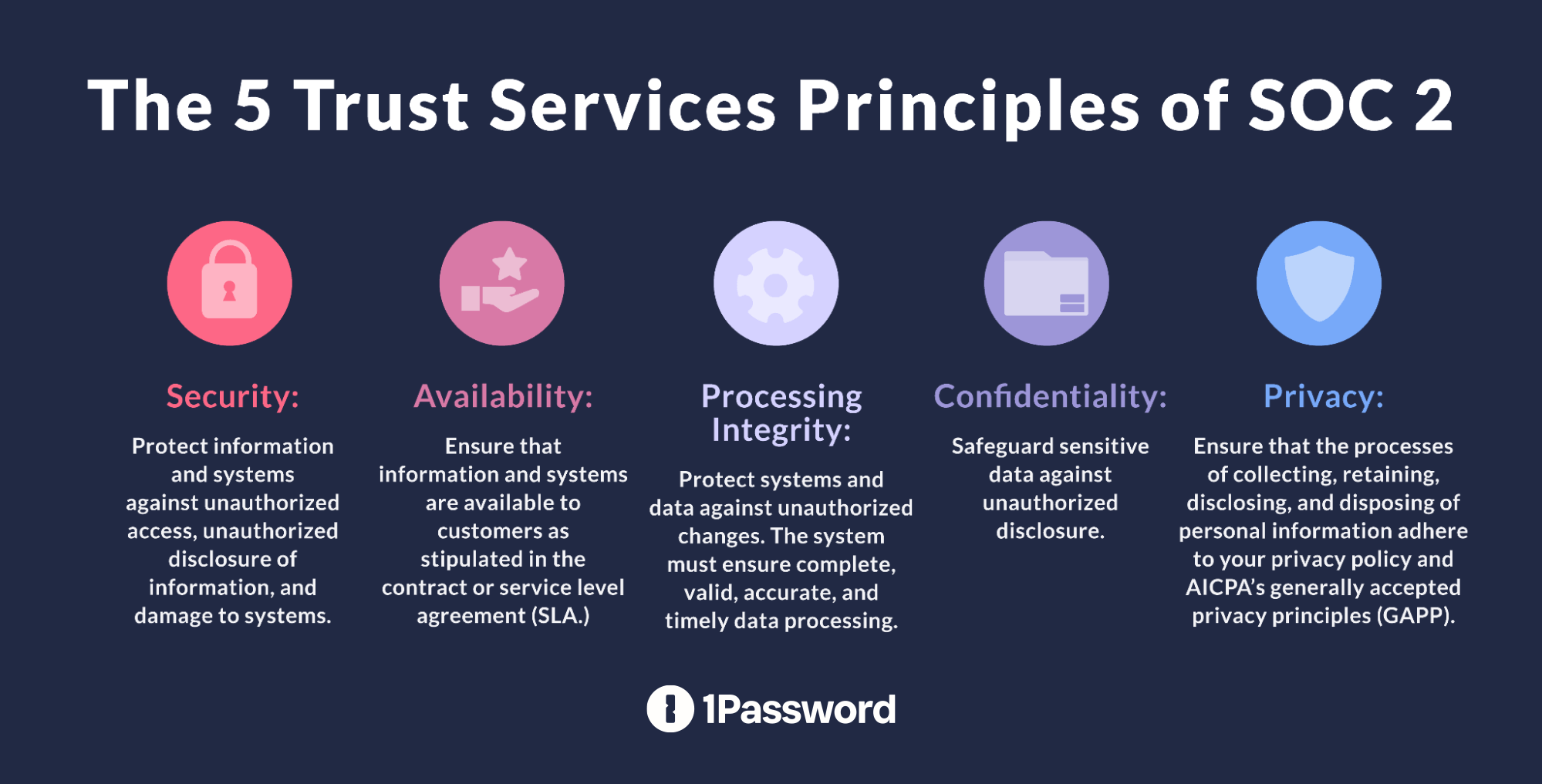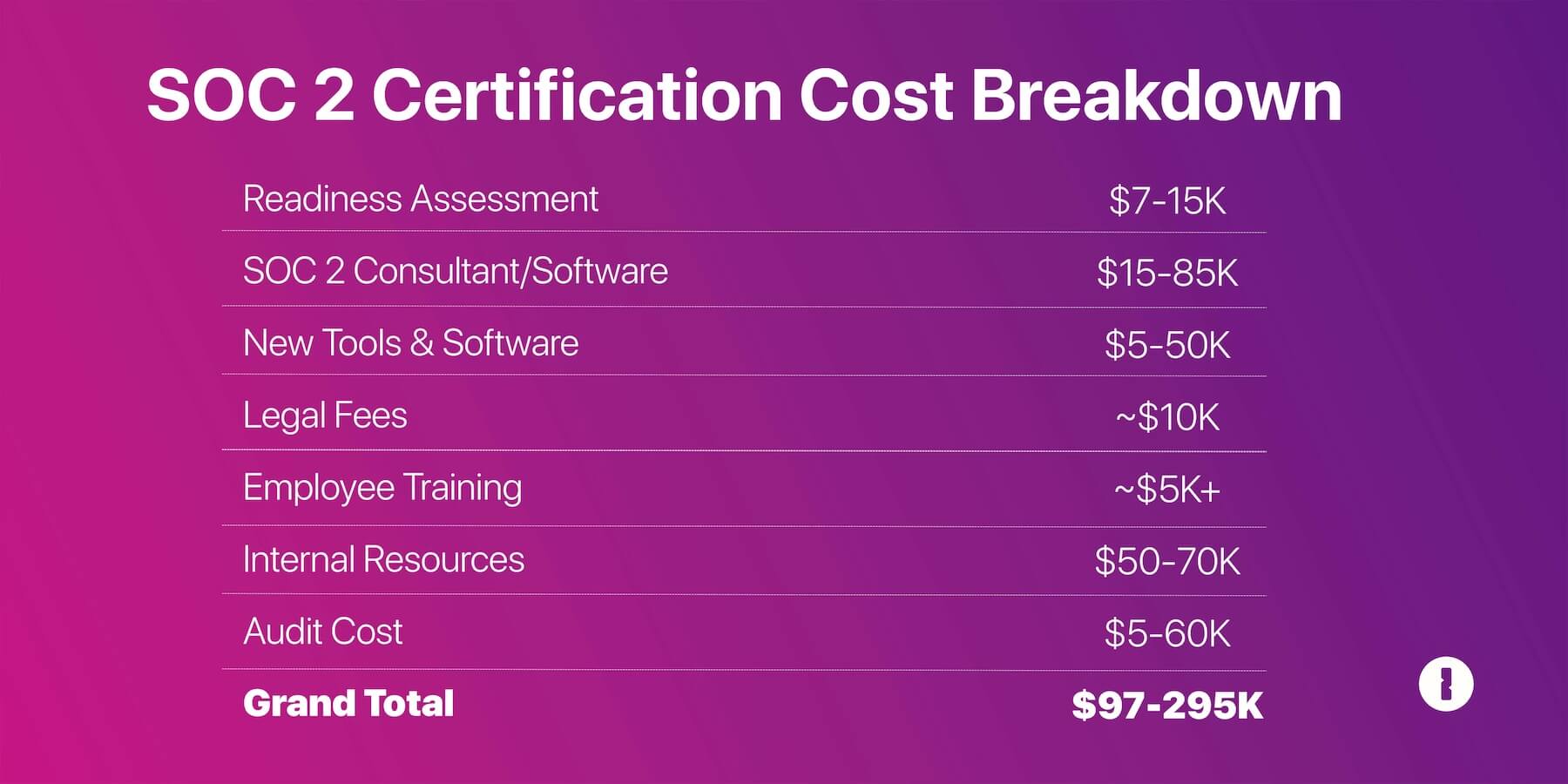This blog breaks down how much businesses can expect to spend on a SOC 2 audit, depending on their size, structure, and what they hope to achieve.
Every article you’ll find on SOC 2 costs can agree on the following statements:
There’s no single, universal answer to the question: “How much does SOC 2 certification cost?”
The total costs of an audit – including all the knock-on expenses associated with it – can range from tens to hundreds of thousands of dollars.
Unfortunately, few articles explain what specific factors influence an audit’s cost, and what businesses can do to mitigate them.
At 1Password, we know a few things about SOC 2, because we’ve gone through the process of becoming SOC 2 compliant ourselves, and because our customers use our products for their own compliance needs. Given that, we’re happy to go where few articles on this topic have gone before: into the specifics.
For this blog, we talked to Ed Gardner, the CEO and principal consultant at New England Safety Partners. He broke down how much businesses can expect to spend depending on their size, structure, and what they hope to achieve.
“A SOC 2 audit is as meaningful as you want it to be,” according to Ed. “And if you need it to be meaningful, you probably need to spend a little money.”
Factors affecting SOC 2 certification cost
There are many variables that influence the cost of a SOC report. Some are in your control and some aren’t, but you can account for each of them in your decision making.
Company size and audit scope
This is a pretty straightforward factor: the higher the number of employees and systems within your company, the more information your auditor has to look at, and the greater the cost.
For a company with multiple products, in which different teams use different workplace management platforms, costs can quickly balloon, because the auditor has to determine the compliance of each team independently.
Still, companies with multiple products and systems can manage costs by narrowing the scope of their SOC 2 audit to a single product. “The auditors look at enough back office stuff that it feels like you’re attesting to your entire company,” Ed says. “But you’re not; you’re just attesting to the product or service, and the back office functions that support that product or service.”
Type of SOC 2 report
Generally, a SOC 2 Type 2 report costs 30-50% more than SOC 2 Type 1, because it looks at data over a period of time, instead of a single point.
However, many CPAs will negotiate a deal where they charge roughly equal amounts for each audit, as long as you agree to stick with the same audit firm for a multi-year engagement.
The trust services principles you cover
Before preparing for an audit, you need to identify which Trust Services Criteria (TSC) are in scope for your SOC 2 report. Security is a mandatory criteria, so you can consider that as the base cost. Availability and Confidentiality often add 10-20% to the base cost each. Processing Integrity and Privacy are more complicated, and each tends to add 20-50% in additional costs.

Choosing a CPA firm
You must hire a firm certified by the American Institute of Certified Public Accountants (AICPA) to conduct the audit. But there’s a huge range in cost (and value) from one CPA to the next.
A reputable firm could charge around $35,000, while a specialist firm that focuses on SOC 2 compliance might run closer to $45,000. Meanwhile, if you go with a “Big 4” accounting firm, the fee could easily be $60,000 or above.
According to Ed, more expensive auditors ask tougher questions, and are less likely to take you at your word. But they also come with name recognition, and if you’re trying to use your SOC 2 report to close deals, your auditor’s reputation will impact your customer’s confidence in your data security.
“You get what you pay for,” says Ed. “A more expensive auditor will be more experienced, more thorough, and you’ll end up with a higher-quality report.”
When you’re budgeting for SOC 2 certification, the audit itself is just the tip of the iceberg. The lion’s share of spending will be on the tools and personnel you need to get compliant. One note to keep in mind for this section is that our estimates are based on small to mid-sized companies. For huge enterprises, each cost can run much higher.
Readiness assessment: $7-15k
At the beginning of the SOC 2 compliance process, your auditors will give you a readiness assessment and gap analysis, which will highlight issues you need to address before the final audit. The assessment will make recommendations about various processes you need to document, like an official org chart and an incident response plan.
The cost of this report depends on various factors, including the TSCs you choose for your report and how far you are from achieving compliance.
SOC 2 consultant/software: $15-85k
Most companies rely on third party help to complete SOC 2 reporting, and this help can come from professional consultants like Ed, compliance software like Drata or Tugboat, or a combination of the two.
You can save time and money by using software that relies heavily on automation, especially if you’re working with an auditor who is familiar with your software. As Ed explains, “a Drata SOC 2 Type 1 audit with a Drata auditor can cost anywhere from $15-25k, as opposed to $30-35k with a consultant.”
But of course, going the automated route comes with its own drawbacks. Standardized platforms mean a standardized approach to the audit. You either do things their way, or you don’t get a shiny green checkmark on your compliance checklist. By contrast, a human consultant can help you take a more customized approach to compliance by advocating for you with the auditors. Their input can save you from making needless (and potentially costly) changes to how you do business.
Another thing to keep in mind is that a lot of compliance software includes multiple compliance-adjacent features – from automated employee onboarding/offboarding, to employee training, to ready-made security policies. This SaaS approach can be helpful, especially when you graduate to SOC 2 Type 2, but maintaining these programs means accepting a recurring cost (and the risk of vendor lock), as opposed to the one-time fee of a consultant.
New tools and software: $5-50k
This cost varies a lot depending on your existing IT infrastructure and cybersecurity posture. If you’re a young startup and this is your first audit, you may have to invest in new software to maintain asset inventory, track compliance tickets, and manage compliance reporting.
You may also need to purchase security tools for threat and intrusion detection, file integrity monitoring, and vulnerability management if you don’t have them already.
A DIY approach will likely cost less money but more time. Meanwhile, a commercial solution may cost more, but require less time to implement.
Legal fees: ~$10k
You’ll want to set aside time and budget to review all customer, vendor, and employee contracts or agreements with your in-house legal team or external attorney. Not everyone does this step, but the process will help you assign responsibilities and establish policies on the various TSCs.
Employee training: ~$5k, but scales to the number of employees
The SOC 2 audit emphasizes the importance of employee training, so you’ll need to implement cybersecurity education programs and track employees' participation. When it comes to the training, auditors will accept most commercially available solutions, and their costs will correspond to the size of your company.
Unfortunately, this is one of those areas where SOC 2 can just be a “check the box” experience. As Ed points out, “auditors are manifestly not equipped to evaluate the quality of the training.” So it’s up to you to make sure your security awareness training is relevant and effective, and that will likely mean going beyond whatever pre-packaged courses you purchase.
Internal resources: $50-70k
The time spent on SOC 2 compliance by an employee or team is the easiest to forget about, but it’s crucial to account for.
An SOC 2 audit is a complex process, and you can’t have a junior staff member handle it “on the side.” Identify a dedicated employee who has sufficient technical knowledge to answer the questions and is senior enough to navigate company politics and make the necessary changes. According to Ed, the point person for SOC 2 can be from operations, legal, IT, security, or engineering.
For a smaller company, the SOC 2 Type 1 audit can take roughly five months from start to finish: two months of gap remediation with your consultant, two months to collect evidence and documentation from the auditor’s request list, and two weeks for the audit itself. But again, expect this timeline to vary depending on your company’s size and needs.
Audit cost: $5-60k
Last but not least, you need to hire a CPA firm to conduct the audit. As we discussed above, the audit cost will depend on the scope and complexity of your SOC 2 report, the size of your organization, and the CPA firm you choose.
When it comes to choosing an auditor, match your budget to the goal of your SOC certification. If you’re trying to use your report to close deals with multinational banks, it might be worth springing for a CPA firm with name recognition. But even if your goals aren’t that lofty, resist the temptation to cut corners, and instead invest enough to be sure you’ll be getting a thorough audit.

SOC 2 FAQs
While we can’t provide you with an exact dollar amount for your SOC 2 audit, we can (with Ed’s help) answer some of the most common questions we hear about the audit process.
How can I reduce the cost of a SOC 2 audit?
We’ve already gone over some of the most basic ways to keep costs down, which include:
Limit the audit’s scope to a single product or small set of trust principles
Do as much preparation as possible in-house
Find an auditor whose fee aligns with your needs
The other major way to control long-term compliance costs is to invest in automation throughout your business, and especially in any area that touches on information security.
As Ed explains: “Auditors care about three things: Is the information complete? Is the information accurate? And is the information available in a timely fashion?”
He gives the example of a manual vs automated monitoring process for endpoint security. If an IT admin has to go into the Google console to see that a CPU is at 98%, that’s a manual process. It leaves a lot of room for human error, and for security issues to go unaddressed.
By contrast, in an automated approach, a 98% CPU spike would automatically trigger a support ticket, which can’t be closed until the IT team documents how they resolved the issue. In that scenario, the automated workflow ensures that the right people get the right information quickly, and that the entire interaction is documented.
The same concept applies for less technical issues, like access control. When an employee is offboarded, an automated solution would immediately cut off their access to customer data, instead of requiring an administrator to manually revoke each permission.
Can I get multiple audits at the same time?
Some people advise killing multiple birds with one stone when it comes to compliance, and combining SOC 2 with ISO27001 or HIPAA. Ed strongly discourages this approach.
“I would never do that, especially in year one, because they’re entirely different types of audits,” he says. “For example, you get a lot of latitude in what you get measured on in a SOC 2, but ISO27001 is much more prescriptive.”
Should I get a SOC 2 Type 1 or SOC 2 Type 2 audit?
Ed recommends going the traditional route of getting the SOC 2 Type 1 audit first, instead of jumping straight into SOC 2 Type 2. “Type 1 eases your organization into understanding what it means to be audited. It’s also easier to pass a Type 1 and then stop, take a breath, look at what you just signed up for, and then season to taste,” he explains.
“The problem with going straight to Type 2 is that you don’t know if your internal controls are going to work consistently. You run the risk that you’ll discover problems while the audit is happening, and if you have too many of those, you won’t pass your audit.”
The bottom line is that you shouldn’t go through either SOC 2 audit unless you have a clear understanding of how it will drive business outcomes. “It’s really important to have a legitimate driver to do it, because it is an expensive and pedantic process,” according to Ed. “If you’re smart and you’re a small company, you can still do some of those things that would make you compliant without taking the next step to be formally evaluated. But before you take that step, make sure you have a good reason, because nobody does it for fun.”
Want to learn how 1Password Extended Access Management can help with your compliance process? Schedule a demo today!

 by Elaine Atwell on
by Elaine Atwell on


